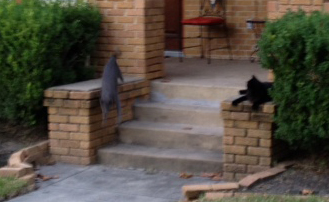
During my “fall tour” of pet industry conferences we are revisiting some of my favorite blogs from the past.
The good news update is that our cats are doing great adopting the front yard and our neighbor’s porch as their preferred hang-out. Black Kitty and GreyGrey come to greet me whenever I am outside without the dogs. Shep still has issues with the cats in his yard and has broken a window in the house twice as a result. He feels in charge of protecting the family and thinks the cats should live in a house, not his yard (as told to Allison, his favorite animal communicator).
We recently relocated two outdoor cats from a feral colony a friend of ours cared for to our backyard. Even though our friend trapped and spayed/neutered the cats the numbers grew and her neighbors started to complain. Bill is allergic to cats so outdoor felines fit our family perfectly.
We knew introduction to the dogs would be tricky, but there are a lot of places in our garage and yard for the cats to hide and be safe. I learned that feral cats need to be contained for at least 2-4 weeks so they get used to sounds and smells of the environment. I created a large screened area customized for all kitty’s needs and found the transition time worked well for the cats and dogs.
The cats have lived in our backyard for six weeks and the dogs are still deciding whether they are friends or foes. Interestingly, each dog seems to have a different perspective on them. Shep actually is the most distressed when he sees them. He barks, whines, paces and whimpers when they move about the yard and he is in the house. Shep is the leader of our pack and definitely likes to have control of every situation. He has always patrolled the yard as his domain so currently sees the cats as foes in his territory.
Archie was my biggest concern due to his prey drive; he’s our little hunter and sometimes bully. When Archie spots one of the cats he barks, chases and will leap up the fence trying to capture his prey. We are surprised that he is actually easier to control than Shep when we recall them from pursuing the cats.
Lacey does not seem to care a bit if there are cats in the yard. She’ll show interest in the excitement of the other two, but displays no other reaction to the presence of the cats.
Early this morning when Shep spotted a cat moving in the dark and the excitement began I reflected on how each dog was reacting to this change in their lives. Shep was still trying to control his life and seems to carry the most emotional distress as a result. Archie reverts to his predator nature, but when distracted from that with obedience cues will forget the cats and his drive and go on about his day. Lacey sees the change and has decided that impact on her is minimal and continues on enjoying her day.
So is the change in our lives a friend or foe? It all depends on our internal perspective and how we see it. If we try to control change like Shep it can result in a lot of stress and frustration. If like Archie we react initially, but stop and think about the reality of impact to us we can usually cope well. The healthiest reaction we learn from Lacey; be open to the change, don’t over react and see a friend.
The difficulty in handling change is our own perception and reactions to it.
Remain calm and figure out how the change is a friend that helps you on life’s journey.







